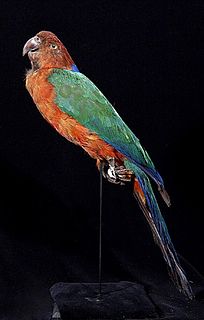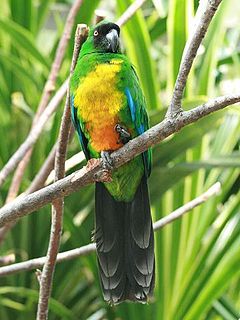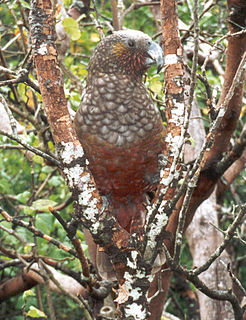 W
WA broad-tailed parrot is any of about 35–40 species belonging to the tribe Platycercini. The members of the tribe are small to medium in size, and all are native to Australasia, Australia in particular, but also New Zealand, New Caledonia, and nearby islands.
 W
WNew Zealand is geographically isolated, and originally lacked any mammalian predators, hence parrots evolved to fill habitats from the ground dwelling kakapo to the alpine dwelling kea as well as a variety of forest species. The arrival of Māori, then European settlers with their attendant animals, habitat destruction and even deliberate targeting, has resulted in their numbers plummeting. Today one species is on the brink of extinction and three other species range from vulnerable to critically endangered. Further parrot species were not introduced by acclimatisation societies, but occasion releases, both deliberate and accidental, have resulted in self-sustaining populations of some Australian species.
 W
WThe Chatham parakeet (Cyanoramphus forbesi), also known as Forbes' parakeet, is a rare parakeet endemic to the Chatham Islands group, New Zealand. This parakeet is one of New Zealand's rarest birds and is classified as Vulnerable on the IUCN Red List, as a result of a range of threats to the species survival, including habitat loss, predation, and hybridization. A number of conservation methods have been employed to assist the recovery of this species, and currently the population trend is considered stable.
 W
WThe cockatiel, also known as weiro bird, or quarrion, is a small parrot that is a member of its own branch of the cockatoo family endemic to Australia. They are prized as household pets and companion parrots throughout the world and are relatively easy to breed. As a caged bird, cockatiels are second in popularity only to the budgerigar.
 W
WThe crimson shining parrot is a parrot from Fiji. The species is endemic to the islands of Kadavu and Ono in the Kadavu Group. The species was once considered conspecific with the red shining parrot of Vanua Levu and Taveuni, but is now considered its own species. The species is sometimes known as the Kadavu musk parrot.
 W
WThe Geelvink pygmy parrot is a species of parrot in the family Psittacidae endemic to Biak and Numfoor islands in Western New Guinea. The name Geelvink comes from a Dutch ship and family called Geelvinck. It has two subspecies; the nominate occurs on Numfor, and M. g. misoriensis on Biak.
 W
WThe kakapo, also called owl parrot, is a species of large, flightless, nocturnal, ground-dwelling parrot of the super-family Strigopoidea, endemic to New Zealand.
 W
WThe three species of kākāriki, or New Zealand parakeets, are the most common species of parakeets in the genus Cyanoramphus, family Psittacidae. The birds' Māori name, which is the most commonly used, means "small parrot". The etymology is: from kākā, parrot + riki, small. The word is also used to refer to the colour green because of the birds' predominantly green plumage. The patches of red on the birds' rumps are, according to legend, the blood of the demigod Tāwhaki. The three species on mainland New Zealand are the yellow-crowned parakeet, the red-crowned parakeet, or red-fronted parakeet, and the critically endangered Malherbe's parakeet or orange-fronted parakeet.
 W
WThe kea is a species of large parrot in the family Nestoridae found in the forested and alpine regions of the South Island of New Zealand. About 48 cm (19 in) long, it is mostly olive-green with a brilliant orange under its wings and has a large, narrow, curved, grey-brown upper beak. The kea is the world's only alpine parrot. Its omnivorous diet includes carrion, but consists mainly of roots, leaves, berries, nectar, and insects. Now uncommon, the kea was once killed for bounty due to concerns by the sheep-farming community that it attacked livestock, especially sheep. In 1986, it received full protection under the Wildlife Act.
 W
WThe maroon shining parrot or red shining-parrot, Prosopeia tabuensis, is a species of parrot in the family Psittaculidae. It is endemic to the islands of Vanua Levu and Taveuni in Fiji and was introduced to the islands of southern Tonga in prehistoric times. The species is sometimes considered conspecific with the crimson shining-parrot of Kadavu. Its natural habitats are subtropical or tropical moist lowland forests and subtropical or tropical mangrove forests.
 W
WThe masked shining parrot, also known as the masked parrot, masked musk parrot, or the yellow-breasted musk parrot is a species of parrot in the family Psittaculidae. It is endemic to Viti Levu in Fiji. Its natural habitats are subtropical or tropical moist lowland forest, subtropical or tropical mangrove forest, subtropical or tropical moist montane forest, arable land, and rural gardens. It is threatened by habitat loss.
 W
WThe genus Nestor is the type and only extant genus of the parrot family Nestoridae. Together with the kakapo, and the extinct parrots in the genus Nelepsittacus, they form the parrot superfamily Strigopoidea. The genus Nestor contains two extant parrot species from New Zealand and two extinct species from Norfolk Island and Chatham Island, New Zealand, respectively. All species are large stocky birds with short squarish tails. A defining characteristic of the genus is the tongue, which is tipped with a hair-like fringe. The superficial resemblance of this tongue to that of lorikeets has led some taxonomists to consider the two groups closely related, but DNA evidence shows they are not.
 W
WThe Antipodes parakeet or Antipodes Island parakeet is a parrot in the family Psittaculidae that is endemic to the Antipodes Islands of New Zealand. It is one of two parrot species found on the islands, and one of only five ground-dwelling parrots in the world. They are long-living birds that may live up to 10 years of age, but the introduction of mice that compete with them for food is a threat to their survival on the Antipodes Islands. Unusually for parrots, they sometimes prey upon other birds, a trait shared by another New Zealand parrot, the kea.
 W
WMalherbe's parakeet, usually known as the orange-fronted parakeet, is a small parrot endemic to New Zealand. In New Zealand it is always known as the orange-fronted parakeet, a name it shares with a species from Central America, while in the rest of the world it is known as Malherbe's parakeet. Restricted to a few valleys in the South Island and four offshore islands, its population declined to around 200 in the 1990s, and it is considered critically endangered.
 W
WThe red-crowned parakeet, also known as red-fronted parakeet and by its Māori name of kākāriki, is a small parrot from New Zealand. It is characterised by its bright green plumage and the red pattern on its head. This versatile bird can feed on a variety food items and can be found in many habitat types. It used to be classified as near threatened as invasive predators had pushed it out of its historical range but it is now at least concern. This species used to occupy the entire island, but is now confined to only a few areas on the mainland and some offshore islands.
 W
WReischek's parakeet is a small green parrot confined to 21 km2 Antipodes Island, one of New Zealand’s subantarctic islands, which it shares with a congener, the larger Antipodes parakeet.
 W
WThe black-lored parrot also known as the Buru green parrot, is a parrot endemic to the Indonesian island of Buru. It is a 40 cm (16 in) long green parrot with black lores, and a turquoise crown. Males have red beaks, and females are gray-brown. The singing is high pitched and more protracted as compared to similar species, such as great-billed parrot.
 W
WThe Australian king parrot is endemic to eastern Australia ranging from Cooktown in Queensland to Port Campbell in Victoria. Found in humid and heavily forested upland regions of the eastern portion of the continent, including eucalyptus wooded areas in and directly adjacent to subtropical and temperate rainforest. They feed on fruits and seeds gathered from trees or on the ground.
 W
WThe shining parrots, Prosopeia, are a genus of parrots.
 W
WThe green rosella or Tasmanian rosella is a species of parrot native to Tasmania and Bass Strait islands. It was described by the German naturalist Johann Friedrich Gmelin in 1788, and named on the mistaken assumption it came from New Caledonia. At 37 cm (14.5 in) long it is the largest species of the rosella genus, Platycercus. Two subspecies are recognised. The green rosella's underparts, neck and head are yellow, with a red band above the beak and violet-blue cheeks. The back is mostly black and green, and its long tail blue and green. The sexes have similar plumage, except the female has duller yellow plumage and more prominent red markings, as well as a smaller beak. Juvenile and immature birds have predominantly green plumage.
 W
WThe shining parrots, Prosopeia, are a genus of parrots.
 W
WVini is a genus of birds endemic to the islands of the tropical Pacific. There are five extant species of these small lorikeets ranging from eastern Fiji through Samoa, French Polynesia, and as far east as Henderson Island. All members of the genus have exceptional bright plumage, particularly the unusual all over blues of the blue lorikeet and the ultramarine lorikeet. The collared lory is sometimes considered to be in this genus; for example, David Steadman listed Phigys as a subgenus of Vini in 2006.